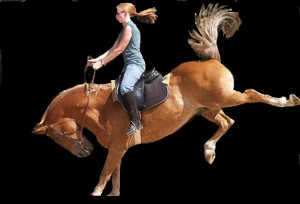 If you’ve trained a lot of horses, you probably already know that when you’re starting a colt, it’s not always a bad thing to let them buck. But I’ve talked to a few trainers who wholeheartedly disagree with me on the subject, and I’ve heard stories about people who have the mindset that letting a colt buck will ruin them and make them predisposed to bucking. My goal for this post is to weigh the pros and cons, explore the nature of the horse, and hopefully educate the reader.
If you’ve trained a lot of horses, you probably already know that when you’re starting a colt, it’s not always a bad thing to let them buck. But I’ve talked to a few trainers who wholeheartedly disagree with me on the subject, and I’ve heard stories about people who have the mindset that letting a colt buck will ruin them and make them predisposed to bucking. My goal for this post is to weigh the pros and cons, explore the nature of the horse, and hopefully educate the reader.
This is a topic of great contention in my family. I live 1200 miles away from my parents, and when I do go to see them once or twice a year, I try to work on a horse or two while I’m there. They raise a couple of colts a year, and so the supply of fresh horses to train is endless. My little sister lives with them and most of the horse training falls on her, as she is just as horse crazy as I am. But she is also their only ranch help, and so she is often working in the hayfield driving a tractor, or helping them work their irrigation systems, or loading hay bales and other such non-horse related stuff. So while she lives and works on the ranch full time, she can’t exclusively spend her time training horses. When there is cattle work to be done, she often uses one of the horses that is already handy with a cow. So, like I said, there are a lot of horses needing trained at their place, which I love!
Anyway, when I’m out there with them, I get in the biggest arguments with my little sister. They had a beautiful blue roan stallion with really good foundation bloodlines and a good working build. They got one crop of foals out of him and sold him because she didn’t like that he bucked with the saddle. I reminded her that every good cowhorse we’ve ever raised (including Red, Dad’s best ranch gelding to this day) was a hard bucker. To me, watching a colt buck the first few times under saddle meant that he had the brains and the pluck to be one heck of a horse later on.
My sister told me that to begin training their three year old blue roan stallion, she put a child’s saddle on him and led him around to get him used to the feel. She also tied him up with the saddle and let him stand. Then she tied a bag full of barley up on the saddle, to simulate the weight of a rider in the saddle. I guess while she did chores or whatever, the stallion got loose and bucked all over the place and didn’t stop until that barley bag was hanging underneath him, and he was a quivering mass of nerves. So, because he was a “bucker”, she decided he wasn’t a good fit for them as a ranch sire, and they sold him.
I just shook my head at hearing her story, because there was no use berating her after the fact. But it made me wish I could spend a few months with them, helping her work colts and getting a few of them started on the way to a higher education of horse life. My sister’s viewpoint is that a colt should learn to carry a saddle and then a rider without ever giving the horse the opportunity to buck, because the horse will then buck often with the rider, and may develop a habit of bucking whenever it is ridden. While there are some horses that seem to “enjoy” bucking, I think they are very few and far between. A horse naturally wants to take the easy route, and generally will only buck if provoked.
My method for starting under saddle would involve some groundwork, saddling, letting the horse move freely in a round pen at all gaits until the feel of the saddle is no longer a spooky thing. If, when trotting or loping, the colt feels the urge to buck, by all means let him buck. He will likely buck the first time he lopes under saddle, and it is a learning time for both the colt and the trainer. I would watch the scope of the horse’s bucking, see how they way he’s built lends itself to athleticism or not, and mentally gauge whether or not the horse is a hard bucker or really not athletic enough to be a danger to a rider. It gives me an idea of how tight I need to hold on later, when I first get up in the saddle! While bucking, the colt learns that the saddle and its flopping stirrups really don’t go away if he bucks, and that bucking with a saddle on isn’t exactly a good feeling, and he might decide that it’s way more work than he wants to engage in. Chances are, he won’t buck again. But I would free-lunge him under saddle a few minutes before riding, for the first several rides, just to be sure. Let him get the bucks out before you get on.
One of the worst things to do is to let a colt think that he can’t move with a saddle on. You’ll see this sometimes when you saddle for the first time, and try to get him to lead or move around the pen, and he is just quivering, afraid to move. If he does move, it may be all in a rush. This actually makes that first ride very dangerous, if a colt “freezes up” and won’t move, and then when you finally get him to move, it’s an explosion of bucking and bolting. That’s why a round pen is so beneficial, you can ask the colt to move first with just the saddle on and get used to it, and then that first ride is just a repetition of what he’s already used to, and you never get that fear in the horse, nor the bucking scenario.
I recently read a magazine article (and can’t, for the life of me remember which magazine or which trainer, but I think it was the AQHA magazine, America’s Horse) where the trainer was giving a clinic and a woman brought him her horse she’d been riding. He was working the horse a little on the ground, and the horse went to bucking. The woman was rather upset and said, “I’ve been working with him for months, and doing everything I can to keep him from bucking!” And the trainer told her, “You’ve actually prevented him from learning this lesson for all those months.” The horse needed to get that bucking session over with so he could proceed with his training and move on past that point.
I would never try to purposely make a horse buck. After all, you really don’t want a horse to be a bucker. But preventing a horse from bucking actually works against you, if that’s what he needs to get out of the way first in his education. So I would give every horse the chance, and then move on from there. Not every horse will choose to buck. Some horses just aren’t built for it conformationally, they may work off their rear end more than their front end, and rearing may be their thing instead. (Me, I’d rather have a bucker than a rearer!) But anyway, let the colt have that opportunity, and then let him settle down to the job of carrying a rider and behaving under saddle.


{ 1 comment }
Wow, what a scary picture. I wouldent want be on that horse when it’s bucking. (In English) Keep your site going! It’s great! Love reading your posts!
{ 1 trackback }